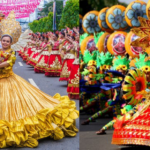In the vibrant tapestry of Philippine festivals, the Ati-Atihan Festival stands out as one of the most dynamic and spirited celebrations, capturing the essence of joy, faith, and cultural pride.
In the vibrant tapestry of Philippine festivals, the Ati-Atihan Festival stands out as one of the most dynamic and spirited celebrations, capturing the essence of joy, faith, and cultural pride. Rooted in the rich history of the country, particularly in Kalibo, Aklan, the Ati-Atihan Festival is an exuberant expression of gratitude, camaraderie, and a profound connection to the nation’s heritage.
The Ati-Atihan Festival traces its origins to the 13th century, a time when Malay chieftains and their followers migrated to the Philippines, encountering the indigenous Ati people in Panay Island. The festival’s name, “Ati-Atihan,” is derived from the term “ati,” referring to the local Aeta or Ati people, and “atihan,” meaning “to make like” or “to pretend.” The festival, which typically takes place in January, has evolved into a colorful and dynamic celebration that attracts both locals and tourists from around the world.
At its core, the Ati-Atihan Festival is a religious feast in honor of the Santo Niño (the Holy Child) and the feast of the Child Jesus. The vibrant festivities are marked by a unique blend of indigenous animistic practices, Spanish-influenced Catholic traditions, and a lively street party atmosphere. Pilgrims and revelers alike come together to celebrate faith, resilience, and the interconnectedness of Filipino culture.
The highlight of the Ati-Atihan Festival is the street dancing, where participants, locally known as “tribes” or “tribus,” don colorful costumes and paint their bodies in intricate designs that mimic the appearance of the dark-skinned Ati people
The highlight of the Ati-Atihan Festival is the street dancing, where participants, locally known as “tribes” or “tribus,” don colorful costumes and paint their bodies in intricate designs that mimic the appearance of the dark-skinned Ati people. The rhythmic beat of drums and other traditional instruments permeates the air as the tribes move gracefully through the streets, their dance paying homage to the ancient Ati settlers and their harmonious coexistence with the Malay newcomers.
A distinctive feature of the Ati-Atihan Festival is the “Hala Bira! This spirited cry, accompanied by lively music and synchronized dance movements, creates an electrifying atmosphere that reflects the joyous spirit of the festival. It’s a collective expression of exuberance, fostering a sense of unity and shared celebration.
The revelry extends beyond the streets, with various events and activities taking place throughout the festival. The “Pamukaw” kicks off the celebrations, waking up the town with a pre-dawn parade and music. The “Pahilot” is a religious ritual where images of the Santo Niño are ritually bathed and dressed, symbolizing purity and renewal. The “Sadsad Pagpasundayag” showcases more choreographed street dancing, with each tribe vying for the coveted title of champion.
Apart from the religious and cultural aspects, the Ati-Atihan Festival has also become an economic boon for Kalibo.
Apart from the religious and cultural aspects, the Ati-Atihan Festival has also become an economic boon for Kalibo. The influx of visitors stimulates local businesses, from food vendors offering traditional Filipino delicacies to artisans selling handmade crafts and souvenirs. The festival has become a platform for showcasing not only the town’s cultural heritage but also its economic vitality.
Over the years, the Ati-Atihan Festival has evolved from a local celebration to a global spectacle, drawing visitors from different parts of the Philippines and beyond. Its significance transcends mere revelry; it serves as a testament to the resilience, creativity, and unity of the Filipino people. The Ati-Atihan Festival stands as a living testament to the diverse and dynamic cultural landscape of the Philippines, where tradition and modernity come together in a harmonious celebration of life, faith, and community.

